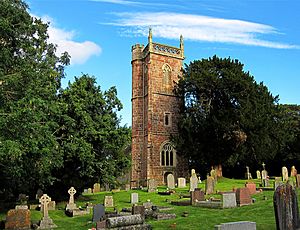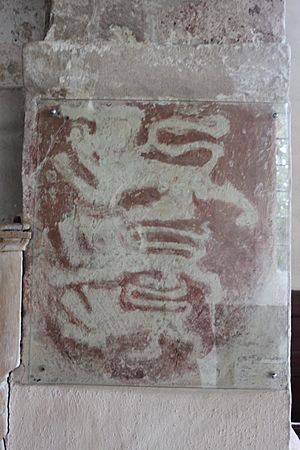Church of St James, Cameley facts for kids
Quick facts for kids Church of St James |
|
|---|---|
 |
|
| Location | Cameley, Somerset, England |
| Built | 12th century |
|
Listed Building – Grade I
|
|
| Designated | 21 September 1960 |
| Reference no. | 1320783 |
| Lua error in Module:Location_map at line 420: attempt to index field 'wikibase' (a nil value). | |
The Church of St James is an old church in Cameley, Somerset, England. It was built a long time ago, in the late 1100s. It is a very important historical building, listed as Grade I. This means it is a super special building that needs to be protected. The Churches Conservation Trust looks after it now.
The church is named after St. James of Compostela. It stopped being used for regular church services on January 1, 1980. The Trust took over its care on March 18, 1981.
Contents
Discovering the Church of St James
Inside the church, on the walls of the main area (called the nave), you can see pieces of old paintings. These paintings were made between the 1100s and the 1600s. One of the oldest paintings shows a jester, or a playful character. This jester has a split lip and a forked tongue, and is holding a scroll.
Royal Connections and Family Symbols
On the north side of the arch leading to the altar area, there is a painting of the three lions. These lions are part of the Royal Arms of England. This suggests that the royal family might have supported the church a long time ago.
On the south side of the arch, there is a coat of arms with two red zig-zag lines. People believe this belongs to the St Maur family. This family was connected to the Knights Templar, a famous group of medieval knights. This symbol shows a link between Cameley and Temple Cloud to these knights.
Hidden Messages and Art
Above the arch leading to the altar, there is a beautiful painting from the early 1600s. It shows the Ten Commandments framed by twisting leaves and cherub faces. These paintings were hidden behind white paint until the 1960s. Because of this, a writer named John Betjeman called it "Rip Van Winkle's Church." This was like the story of Rip Van Winkle, who slept for many years.

Galleries and Memorials
The church has two special viewing areas called galleries. The west gallery was built in 1711. It has fancy wooden railings (balusters) in a style from the time of King James I. It also has a coat of arms from the time of Charles I of England. The south gallery was added later, in 1819.
On the north wall of the main church area, there are two memorials from the early 1800s. These remember members of the Rees-Mogg family. There is also a metal plaque that remembers nine people from the village. They sadly died during World War I. The church is surrounded by many trees.
The Church Tower
The church tower was probably built in the 1400s and fixed up in the 1800s. It is made of red stone from the Mendip Hills. This red stone looks different from the blue stone used for the rest of the church. Inside the tower, there is a bell made in 1779 by the Bilbie family, who were famous bell makers.
Some of the old stone monuments in the churchyard are also important. They are listed as Grade II historical buildings. The church is part of a larger group of churches in the area.
See also
- List of Grade I listed buildings in Bath and North East Somerset
- List of towers in Somerset
- List of churches preserved by the Churches Conservation Trust in South West England
- List of ecclesiastical parishes in the Diocese of Bath and Wells

